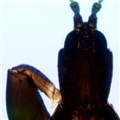Acanthothrips albivittatus
Recognition data
Distinguishing features
Both sexes fully winged. Body dark brown, with chalky-white band laterally from posterior margin of eye to abdominal tergite VIII; antennal segments uniformly dark; forewing pale with darker line medially. Head longer than wide; cheeks without prominent bristle-bearing warts; eyes large; maxillary stylets long and close together medially; postocular setae long and pointed; mouth cone extending across prosternum. Antennae 8-segmented; segments III � VI constricted to apical neck; III � IV with three stout sensoria. Pronotum reticulate, two pairs of epimeral setae present; basantra absent. Fore tarsus with prominent tooth; fore femora with sub-apical tubercle on inner margin. Forewings weakly constricted medially, granulate between sub-basal seta III and median constriction. Pelta reticulate; tergite IX setae long and pointed. Male sternite VIII with median transverse glandular area; tergite IX setae similar to those of female.
Related and similar species
The genus Acanthothrips includes 13 species, of which one is Holarctic, five are described from North America, six are from the Neotropics including Mexico, and one is from Japan. Priesner (1964) distinguished this genus from the wordwide genus Hoplandrothrips on the basis that the forewings are parallel sided. Although this is true of A. nodicornis , the forewings of A. albivittatus and A. argentifer are constricted medially at least as much as in some species of Hoplandrothrips. The antennae of A. albivittatus are uniformly dark, whereas the median antennal segments are largely yellow in the other two species recorded from California.
Taxonomic data
Current valid name
Acanthothrips albivittatus Hood
Original name and synonyms
Acanthothrips albivittatus Hood, 1908: 374
Family placement
Phlaeothripidae, Phlaeothripinae
Biological data
Life history
Breeding on dead branches
Host plants
Unidentified fungal hyphae on dead branches
Tospoviruses vectored
None
Crop damage
None
Distribution data
Area of origin
Possibly northeastern USA
Distribution
Eastern USA (?also California, Placerville - see Cott, 1956: 149)







